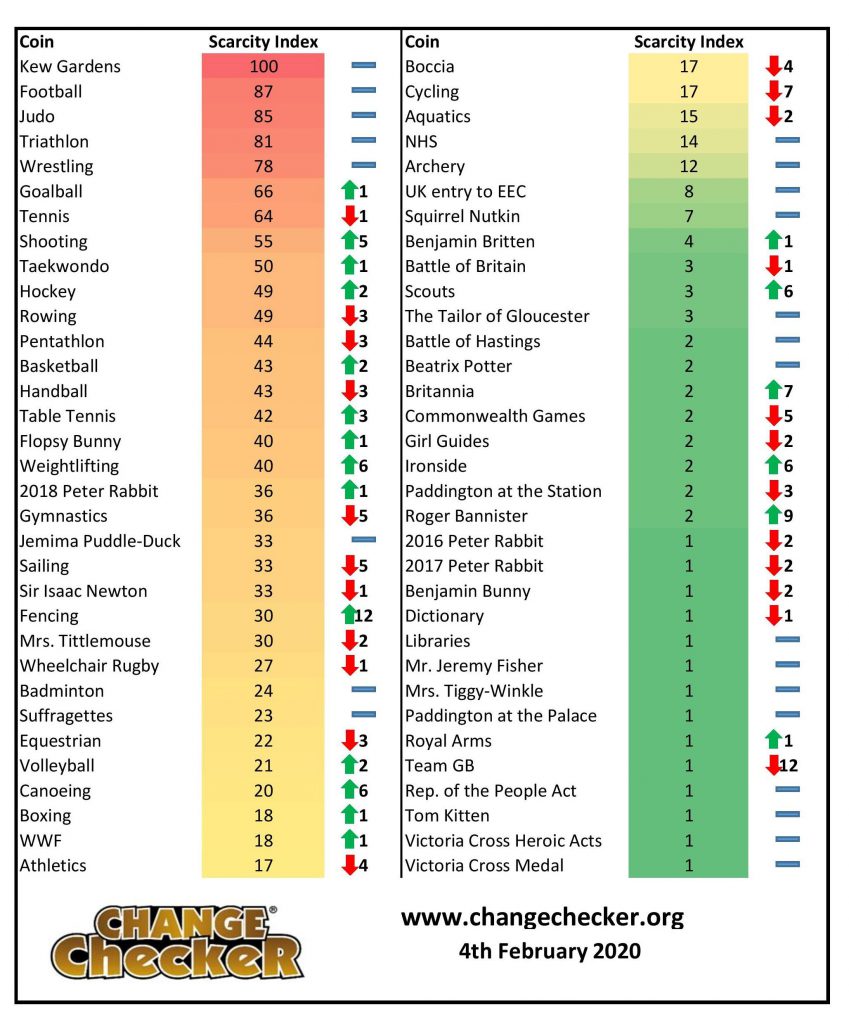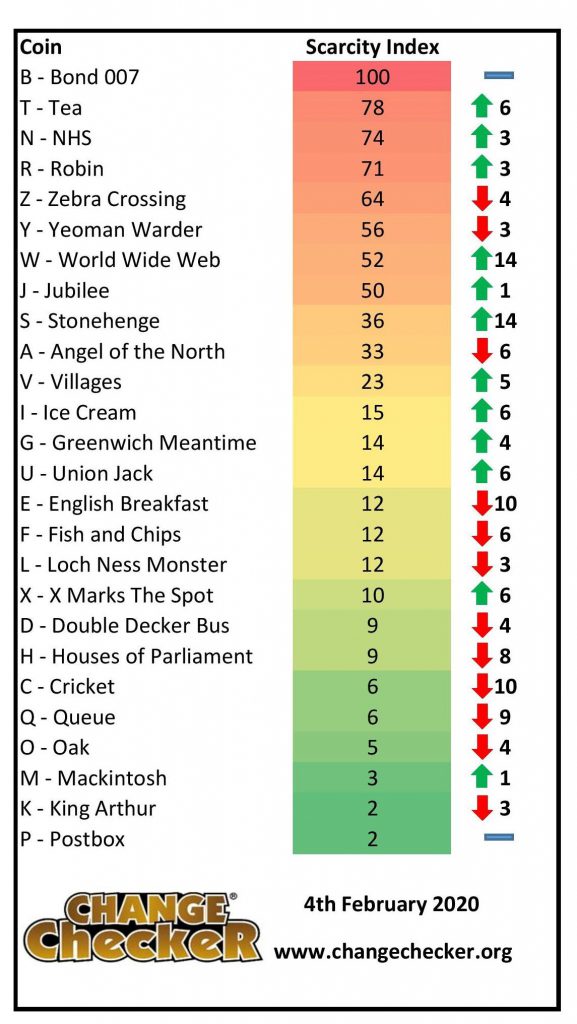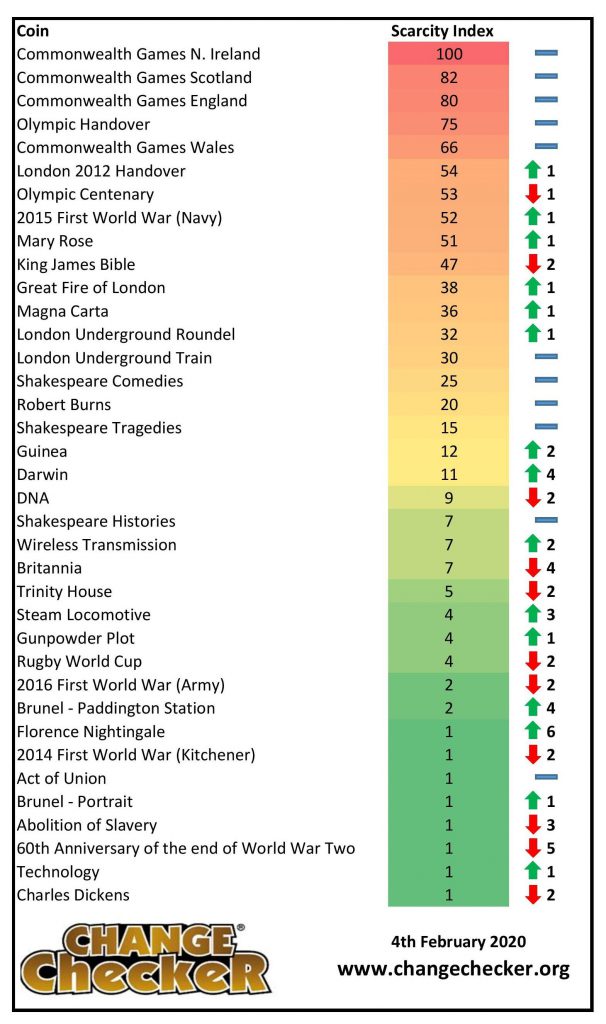General info
2020 Scarcity Index Update!
We’re excited to reveal to you the very first Scarcity Index of 2020!
The updated 50p, A-Z 10p and £2 indexes below allow you to discover how sought-after the coins in your collection really are…
This information has been compiled using data from the Change Checker Swap Centre and presented in the easy to use indexes below, with arrows to signify how many places up or down a coin has moved since the last Scarcity Index.
50p Scarcity Index

The previous Scarcity Index update saw some exciting changes to the 50p index, as we were able to include the 2018 50p coins following the release of their mintage figures.
This was great news for Change Checkers who have the 2018 Beatrix Potter 50ps in their collection, as both the Flopsy Bunny and Peter Rabbit 50ps have proved incredibly sought-after.
Despite both coins having the same mintage figure of 1,400,000, the Flopsy Bunny 50p is the most sought-after of the Beatrix Potter coins and is in fact the scarcest non-Olympic 50p coin in circulation, aside from of course the Kew Gardens 50p – the UK’s most sought-after circulation 50p.
Whilst both the Flopsy Bunny and 2018 Peter Rabbit 50ps have moved up the index one place since the last update, the other 2018 50ps haven’t fared quite so well, with the Mrs Tittlemouse and Paddington at the Station both moving down the index and the other 2018 50ps remaining unchanged.
The biggest mover on this latest Scarcity Index update goes to the Olympic Fencing 50p, which has moved up the index an incredible twelve places, following its five place drop on the previous update.
As we look forward to the Olympic Games which will be held in Tokyo later this year, perhaps we’ll see more of the Olympic 50ps increase in popularity by the next Scarcity Index update.
A-Z 10p Scarcity Index

We’re used to seeing quite a bit of movement on the A-Z 10p index as these particularly tricky-to-find coins are snapped up by collectors.
Interestingly, in this latest update only the top and bottom coins have remained unchanged, with B for Bond staying on top spot as the current scarcest A-Z 10p coin in circulation.
For many, this coin seems to be a firm favourite from the A-Z of Great Britain collection which was released in 2018, so it comes as no surprise that it has found its way to the top of the list.
P for Postbox is unfortunately bottom of the pile once again, although it’s worth remembering that all of these coins are considered sought-after and collectors fortunate enough to come across just one will be considering themselves lucky.
The biggest movers on the latest 10p index update are W for World Wide Web and S for Stonehenge, which have both moved up the index by 14 places.
S for Stonehenge actually dropped by 14 places in the previous index, so this could be the coin levelling back out again.
It will be interesting to see how the index changes as more collectors come across these coins and as we await the release of the 2019 mintage figures. We currently know that 220,000 of each design entered circulation in 2018 and a further 2.1 million coins overall were released in 2019, but exact figures for individual 2019 designs are currently unknown.
£2 Scarcity Index

Following the 2018 mintage figure reveal, we know that no £2 coins have entered circulation since 2016, so the £2 index continues to remain fairly stable with no new coins to add to the mix.
The top five coins are unchanged since the last index and it comes as no surprise that the Commonwealth Games Northern Ireland £2 remains on the top spot, as this £2 has a mintage figure of just 485,500 and is considered incredibly sought-after amongst collectors.
All three Olympic themed £2 coins (Olympic Handover, Olympic Centenary and London 2012 Handover) also remain very close to the top of the index and I wonder if the Tokyo Olympics this year will affect the scarcity of these already very popular coins.
The biggest mover on the £2 index is the Florence Nightingale coin, which has moved up by six places, whilst the 60th Anniversary of World War Two coin has moved down by five places to the third from bottom space.
As I’m sure you’ll agree, it would be fantastic to see some new £2 coins entering circulation and how they might affect the £2 Scarcity Index. Fingers crossed they’ll be enough demand for these coins to enter circulation soon!
How your Scarcity Index works
Generally collectors have had to rely upon mintage figures to identify the scarcest coins. But they only tell part of the story. Trying to find a good quality coin from 15 – 20 years ago, even for a higher mintage issue, is much more challenging than a more recent issue, as coins become damaged over time and are ultimately removed from circulation.
Additionally, some designs are more hoarded than others by people who might not normally collect coins – the poignant First World War £2 Coin series being an example. Finally, it can be up to a couple of years before the Royal Mint eventually confirms the actual mintage for an issue.
That’s why we have combined the mintage information with two other key pieces of information.
- How many of each design are listed as “collected” by Change Checkers, indicating the relative ease of finding a particular coin.
- The number of times a design has been requested as a swap over the previous 3 months, showing the current level of collector demand.
Importantly, as new coins are released and popularity rises and falls across different designs the Scarcity Index will be updated quarterly allowing Change Checkers to track the relative performance of the UK’s circulation coins.
How much are my coins worth?
The Scarcity Index does not necessarily equate to value but it is certainly an effective indicator. For example, the Kew Gardens 50p coin commands a premium of up to 200 times face value on eBay.
You can use the 6 point guide to help you determine a more realistic value for your coins.
What about £1 Coins?
The £1 Scarcity Index has already been published for the Round £1 coins and, because they are no longer being issued, this is now set in stone.
If you’re interested in coin collecting, our Change Checker web app is completely free to use and allows users to:
– Find and identify the coins in their pocket
– Collect and track the coins they have
– Swap their spare coins with other Change Checkers

Sign up today at: www.changechecker.org/app
Our Top 10 UK Royal Coins
Are you a collector of UK Royal coins?
From celebrating Queen Elizabeth II’s 90th Birthday, to marking Queen Victoria’s accession to the throne in 1837, Royal anniversaries, birthdays and achievements have been commemorated on UK coinage for centuries.
In this blog, we’re going to take a look at what we believe to be the Top 10 UK Royal Coins of all time.
1. 2015 Longest Reigning Monarch £5

As of 2020, HM Queen Elizabeth II became the world’s 5th longest reigning monarch! But in 2015, she became Britain’s, after 63 incredible years on the throne.
To celebrate this momentous occasion The Royal Mint issued a series of commemorative coins, including this 2015 Longest Reigning Monarch £5.
When news of the coin broke, it proved to be popular amongst coin collectors and fans of the Royal Family alike, with The Royal Mint’s website experiencing “overwhelming levels of traffic”. (The Royal Mint Blog)
Unusual in modern times, James Butler has designed both the reverse and the obverse of the coin. His new commemorative portrait of HM The Queen features on the obverse.
2. 2020 UK King George III £5

Next up is the King George III £5 which was initially issued as part of the 2020 Annual Coin Set in January to celebrate the life and reign of Britain’s longest reigning King.
In commemoration of the 200th anniversary since his death, this is the first time that King George III has been celebrated on modern UK coinage – the last time he featured on a coin was 1820!
Included in the reverse design is the royal residence and his place of death, Windsor Palace as well as the King’s Observatory, which was founded by the King himself in 1769!
3. 2016 Queen Elizabeth II’s 90th Birthday £5

As a nation, we’ve celebrated Her Majesty the Queen’s landmark birthdays, jubilees and wedding anniversaries during her long and eventful reign.
When Queen Elizabeth II became the first British monarch to celebrate their 90th Birthday, the release of this £5 coin in 2016 was particularly special and hugely significant for collectors around the world.
This is the only official UK £5 coin to mark this special occasion and it features a design that was approved by The Queen herself! The 9 roses on the reverse, designed by Christopher Hobbs, each represent a decade of Her Majesty’s life.
4. 1838 The Young Head Sovereign

At just 18 years old, Alexandra Victoria acceded to the throne and ruled Britain for an incredible 63 years, making her Britain’s longest reigning monarch at the time of her death in 1901!
This was the very first Sovereign to be issued under Queen Victoria’s rule, issued in 1832, featuring the popular ‘Young Head’ portrait by William Wyon. This portrait was favoured by Victoria and contributed to the coin’s popularity through her reign.
To this day, it is the longest a portrait has featured on Britain’s circulating coinage having been issued on bronze coins up until 1895!
5. 1902 Edward VII Silver Crown

The Edward VII 1902 Silver Crown was issued for one-year-only to celebrate Edward’s coronation – only 256,020 were ever struck. It was the last British crown struck for circulation!
This coin reflects a crucial period in British History, and celebrates the might and confidence of one of the most powerful leaders on earth.
6. 2008 Queen Elizabeth I £5

Elizabeth I succeeded to the throne on 17th November 1558 – a moment of triumph for the underestimated daughter of Henry VIII…
Under her rule, England went from an impoverished country torn apart by religious and political turbulence to the world’s dominant power with victory over the Spanish Armada in 1588.
The Elizabethan era is often considered the golden age of English history with music, art and literature flourishing.
To commemorate 450 years since Elizabeth II’s accession, The Royal Mint issued this £5 in 2008 featuring a portrait of Elizabeth I within a mandorla created by four decorative arches and Tudor roses.
7. 2018 Four Generations of Royalty

This Four Generations of Royalty £5 coin was highly anticipated since the moment HRH Prince George of Cambridge was born on 22nd July 2013.
This was the first time in modern years that The Royal Mint issued a coin that celebrated all four generations of royalty in line to the throne on a single coin. The last time that four generations of royalty were celebrated together was in 1894 under Queen Victoria’s reign!
The reverse design, by Timothy Noad, ornately shows the initials of the current four generations, E, C, W & G and represents the heritage of the House of Windsor.
8. 2000 Queen Mother Centenary £5

Anticipation of the imminent 100th birthday of HM the Queen Mother meant several countries released centenary coins as soon as she entered her 100th year rather than wait for her actual birthday on 4th August 2000.
The Royal Mint struck a £5 coin wholly designed by Ian Rank-Broadley, which included a reverse design of a left-facing profile of the Queen Mother wearing a diamond tiara with her signature underneath; this was the first time this had happened on a British coin!
9. 2017 Platinum Wedding Anniversary £5

On 20th November 2017 Her Majesty Queen Elizabeth II and HRH Prince Philip celebrated their Platinum wedding anniversary, celebrating an unprecedented 70 years together!
To mark the longest marriage in Royal history, The Royal Mint issued a celebratory £5 coin in 2017. It features specially commissioned double portrait of the couple on the obverse, and an engraving of the two riding their much loved horses together on the reverse.
It is estimated just 60 people in the UK celebrated their Platinum Wedding Anniversary in the same year – meaning Her Majesty and HRH Prince Philip are literally one in a million!
10. 2018 Prince Charles 70th Birthday £5

On the 14th November 2018 Prince Charles celebrated his 70th birthday.
To mark this special occasion and to celebrate the longest serving heir apparent, who has shown unwavering dedication to the British people, The Royal Mint issued this £5 coin.
The reverse features a new portrait of the prince, specially designed by Robert Elderton. It is the only official UK coin to have marked The Prince of Wales’ birthday!
Of course there have been so many other incredible UK Royal coins and narrowing it down to just 10 was a tough job, but we certainly feel these coins have got to be highlights!
Let us know which coins UK Royal coins would make it into your Top 10 in the comments below!
If you’re interested in coin collecting, our Change Checker web app is completely free to use and allows users to:
– Find and identify the coins in their pocket
– Collect and track the coins they have
– Swap their spare coins with other Change Checkers

Sign up today at: www.changechecker.org/app
The history of the ‘Ten Bob’ note – a world before the 50p coin…
Back in the 1960’s the 10 Shilling Note, or ‘ten bob’ as it was commonly known, would go pretty far – buying you 6 pints of beer, 10 loaves of bread, or 17 pints of milk.
Nowadays it’s hard to imagine the decimal equivalent, the 50p, buying so much. In fact, 50p can only just buy you one pint of milk today! And you can certainly forget that pint of beer!
But before the much loved 50p came along, the old 10 Shilling banknote had a fascinating history.
From being issued by the Government in a wartime emergency, changing colour to avoid forgery from the Nazis and eventually being replaced by the world’s most popular coin, it’s important that the history of the ten bob isn’t forgotten.
The Emergency Banknote
In August 1914, the British economy was in turmoil due to the instability caused by the oncoming war on the continent.
Bankers and politicians were desperately looking for ways to secure Britain’s finances and prevent the banks from collapsing.
The Government decided that a large supply of banknotes should be made available for the value of 10 Shillings, making it easy for the public to make small transactions.
However, The Bank of England was not able to prepare and print the required number of notes quickly enough, so the Government took the unprecedented step of deciding to issue the notes itself.

These banknotes became known as the Treasury banknotes and were unlike anything the British public had ever seen.
Until this point the lowest denomination banknote was £5, and in those days this was such a large sum that many people would never have seen or used a banknote before.
By issuing a 10 Shilling banknote, the Treasury created the first widely circulated banknotes in England.
The Wartime colour change
In 1928, the responsibility for printing 10 Shilling notes was transferred to the Bank of England.
However, not long afterwards, Britain once again found itself at war and again found its currency under threat.
During World War II, Nazi Germany hatched a plan to undermine British currency.
Through ‘Operation Bernhard’ they believed they had discovered a method to manufacture counterfeit ‘White Fivers’, and planned to distribute these in huge numbers to destabilise the British currency.
The Bank of England decided to take preventative action and, as a result, the 10 Shilling note was changed for the duration of the war to a distinctive pink and blue colour in an attempt to prevent counterfeiting.

It was also revolutionary in the progression of banknote technology by incorporating a metal security thread.
The Nazis couldn’t compete with this high level anti-forgery technology and hence the British 10 Shilling note held strong and supported the British wartime economy, as it had done since its conception.
The 50p revolution
After undergoing a colour change during the Second World War, the ten bob note reverted to its familiar red-brown until 1961, when a new design featuring a portrait of Queen Elizabeth II was introduced.
Despite a new design for the 10 Shilling note featuring Sir Walter Raleigh on the reverse being approved in 1964, as part of the process of decimalisation it was dropped in favour of the new fifty pence coin introduced in 1969.

The principle reason for the change was to save the Treasury money.
The notes had an average lifetime of around five months, whereas a coin could last for fifty years.
The 50p has since gone on to become the world’s most popular and collected coin, but nowadays few realise the fascinating history of its predecessor, the 10 Shilling banknote!
Do you remember the ten bob note? Let us know in the comments below!
If you’re interested in coin collecting, our Change Checker web app is completely free to use and allows users to:
– Find and identify the coins in their pocket
– Collect and track the coins they have
– Swap their spare coins with other Change Checkers

Sign up today at: www.changechecker.org/app




